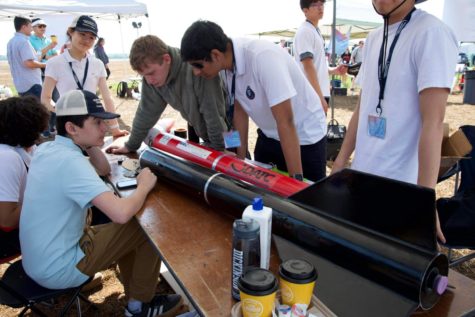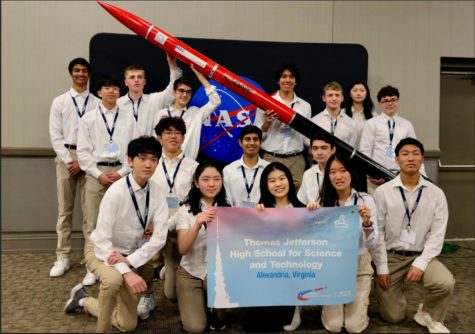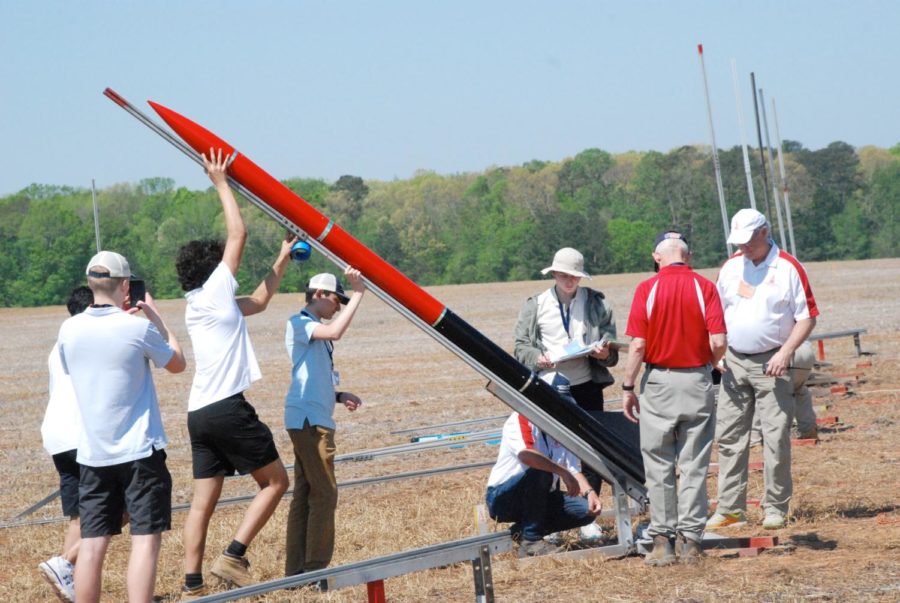NASA Student Launch Initiative Team launches rocket in Alabama
Juniors George Evanisko, Santiago Criado and Larry Schrag and sophomore Deen Nori set up the rocket before the launch. “A big misconception about this program is that most of the effort is in building the rocket or the payload. I would argue that most of the work, literally hundreds of hours, was spent designing and planning prior to building anything,” Criado said.
May 12, 2023
The Jefferson NASA Student Launch Initiative Team (SLI) launched a high-powered rocket on April 15 at NASA’s Marshall Space Flight Center in Huntsville, Alabama. The launch event was by invitation only for all high schools.
“We were invited to submit a proposal because last year, two TJ teams finished in the top 25 nationally in TARC [the Team America Rocketry Challenge],” captain and junior Santiago Criado said. “NASA decides who they accept based on the strength of the proposal.”
After working for nine months, the team successfully launched their rocket. Members of the SLI team met up often, taking time outside of school to build and have test flights.
“My favorite part was building the things that we spent months designing,” Criado said. “The building sessions were mostly conducted outside of school hours and a lot more fun than writing the reports.”
This was the team’s first time participating in the event in about a decade.
“I think that the launch was highly successful, and it was probably the best we could have done given our circumstances,” senior Angie Zhang said. “With the pandemic, we lost [some] of [the] knowledge that would have been passed down to this year’s members.”
The rocket consists of multiple components that separate from each other as it lands.
“The actual rocket is around 12 feet tall. The rocket has several parts, and it goes up to 5000 feet, deploying each part as it comes down with a parachute,” junior Amanda Wang said.

One of the challenges the team encountered while building the rocket involved the payload glider, which is ejected from the rocket and takes a topographic survey. “We had to make a payload for our rocket that did a simple experiment. After that, the main job was actually making this payload work with the rocket,” junior Paul Hwang said.
However, the payload glider did not always operate properly.
“It was only during our final pre-Huntsville try that the glider came out of the rocket and deployed, but even then, one of the wings broke upon landing,” Criado said.
The team also had issues with materials and had a hard time finding the correct motors for the rocket.
“Our motor that we selected for our target altitude was discontinued,” Zhang said. “We got some of the last few remaining in existence, but before we were able to [find them], we were kind of in limbo as to whether we would actually be able to launch a rocket with the motor specified in our proposals.”

Along with constructing the rocket, the team also performed and designed simulations of the rocket. They submitted three different design reviews to NASA for approval.
“We submitted a preliminary design review to NASA that got approved. Then, we started the build process,” Wang said. “When we had a fully finished rocket, we submitted a final design review and presented our review [to NASA].“
At the launch event, the team also presented their rocket and glider at a rocket fair.
“[The] attendees seemed to like our rocket and glider design. We ran into tons of Jefferson alumni attending Carnegie Mellon and Virginia Tech and got to socialize,” Criado said.






